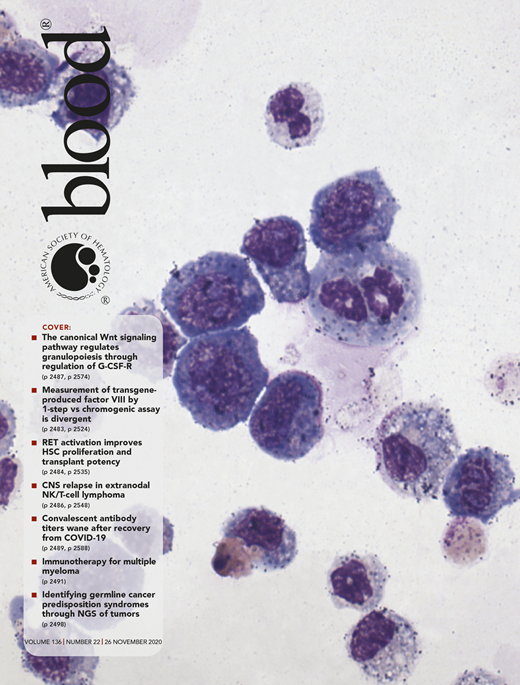A 14-year-old adolescent boy presented with swelling of his neck. Computed tomography scans showed a 4.5-cm conglomeration along the right posterior jugular chain with associated lymphadenopathy bilaterally. Biopsy showed a partially effaced lymph node architecture with nodules surrounded by sclerotic bands (panel A: hematoxylin and eosin [H&E] stain, original magnification ×5); scattered large to giant tumor cells surrounded by small lymphocytes, eosinophils, histiocytes, and neutrophils (panel B: H&E stain, original magnification ×400); tumor cells resembling Reed-Sternberg cells with an “owl’s eye” appearance (panel C: H&E stain, original magnification ×1000); and small clusters of tumor cells, lacunar cells, and mummified cells. The neoplastic cells expressed CD30 (panel D: subset, original magnification ×400), CD15 (panel E: rare, original magnification ×400), fascin, and MUM1 (panel F: subset, original magnification ×400), without CD20, PAX5 (panel G: original magnification ×400), CD79a, CD45, or other lymphoid markers. Tumor cells were strongly positive for Epstein-Barr virus small RNA by in situ hybridization (panel H: ×400; EBER, Epstein-Barr virus encoded RNA). Initially, PAX5-negative nodular sclerosis classic Hodgkin lymphoma was considered. Because of an unexpected positron emission tomography-avid signal in the right nasopharyngeal area, additional stains were performed. Tumor cells, in singles, cords, or aggregates expressed cytokeratins AE1/AE3 (panel I: ×400), CK19 (panel J: ×400), Cam5.2 (panel K: ×400), and p53 but not CK7/20, and revealed a diagnosis of nonkeratinizing squamous cell carcinoma, undifferentiated subtype (formerly nasopharyngeal carcinoma).
This case highlights the striking resemblance between rare metastatic carcinoma and classic Hodgkin lymphoma both clinically and pathologically, posing a potential diagnostic pitfall.
A 14-year-old adolescent boy presented with swelling of his neck. Computed tomography scans showed a 4.5-cm conglomeration along the right posterior jugular chain with associated lymphadenopathy bilaterally. Biopsy showed a partially effaced lymph node architecture with nodules surrounded by sclerotic bands (panel A: hematoxylin and eosin [H&E] stain, original magnification ×5); scattered large to giant tumor cells surrounded by small lymphocytes, eosinophils, histiocytes, and neutrophils (panel B: H&E stain, original magnification ×400); tumor cells resembling Reed-Sternberg cells with an “owl’s eye” appearance (panel C: H&E stain, original magnification ×1000); and small clusters of tumor cells, lacunar cells, and mummified cells. The neoplastic cells expressed CD30 (panel D: subset, original magnification ×400), CD15 (panel E: rare, original magnification ×400), fascin, and MUM1 (panel F: subset, original magnification ×400), without CD20, PAX5 (panel G: original magnification ×400), CD79a, CD45, or other lymphoid markers. Tumor cells were strongly positive for Epstein-Barr virus small RNA by in situ hybridization (panel H: ×400; EBER, Epstein-Barr virus encoded RNA). Initially, PAX5-negative nodular sclerosis classic Hodgkin lymphoma was considered. Because of an unexpected positron emission tomography-avid signal in the right nasopharyngeal area, additional stains were performed. Tumor cells, in singles, cords, or aggregates expressed cytokeratins AE1/AE3 (panel I: ×400), CK19 (panel J: ×400), Cam5.2 (panel K: ×400), and p53 but not CK7/20, and revealed a diagnosis of nonkeratinizing squamous cell carcinoma, undifferentiated subtype (formerly nasopharyngeal carcinoma).
This case highlights the striking resemblance between rare metastatic carcinoma and classic Hodgkin lymphoma both clinically and pathologically, posing a potential diagnostic pitfall.
For additional images, visit the ASH Image Bank, a reference and teaching tool that is continually updated with new atlas and case study images. For more information, visit http://imagebank.hematology.org.

![A 14-year-old adolescent boy presented with swelling of his neck. Computed tomography scans showed a 4.5-cm conglomeration along the right posterior jugular chain with associated lymphadenopathy bilaterally. Biopsy showed a partially effaced lymph node architecture with nodules surrounded by sclerotic bands (panel A: hematoxylin and eosin [H&E] stain, original magnification ×5); scattered large to giant tumor cells surrounded by small lymphocytes, eosinophils, histiocytes, and neutrophils (panel B: H&E stain, original magnification ×400); tumor cells resembling Reed-Sternberg cells with an “owl’s eye” appearance (panel C: H&E stain, original magnification ×1000); and small clusters of tumor cells, lacunar cells, and mummified cells. The neoplastic cells expressed CD30 (panel D: subset, original magnification ×400), CD15 (panel E: rare, original magnification ×400), fascin, and MUM1 (panel F: subset, original magnification ×400), without CD20, PAX5 (panel G: original magnification ×400), CD79a, CD45, or other lymphoid markers. Tumor cells were strongly positive for Epstein-Barr virus small RNA by in situ hybridization (panel H: ×400; EBER, Epstein-Barr virus encoded RNA). Initially, PAX5-negative nodular sclerosis classic Hodgkin lymphoma was considered. Because of an unexpected positron emission tomography-avid signal in the right nasopharyngeal area, additional stains were performed. Tumor cells, in singles, cords, or aggregates expressed cytokeratins AE1/AE3 (panel I: ×400), CK19 (panel J: ×400), Cam5.2 (panel K: ×400), and p53 but not CK7/20, and revealed a diagnosis of nonkeratinizing squamous cell carcinoma, undifferentiated subtype (formerly nasopharyngeal carcinoma).](https://ash.silverchair-cdn.com/ash/content_public/journal/blood/136/22/10.1182_blood.2020009045/1/m_bloodbld2020009045f1.png?Expires=1763468252&Signature=pB05VINu-Y9NdnAU6PlRXH-sVDNtH-GkZeqoEWXxt3X4gZzVt416-5vgtO9ueBi-Xog4kteuxGvTI3z2eghnnICUoUbwR8Glk9i46WmCU6vJXDcKknhoxdIxedHQVe1dkMGXa6kuS--c9DhHkZ2RyIMxH2hOb5MrUssvlXocxf79G~yYcBEWs2x0C37QzgRztqnvqUXJ0M5yLDV6V4ZIqa1bsING3HdSBLrOMQ5f-qTmr8lFAAzEkKFQa8RRwiUp~BvtVahOtN~-GMYh7hso2esa8Vm~qY5hz7lSLMzVS44VZsBHasdHe6heapGAqyQXp2cr57vk02aOHXBFQJWTsQ__&Key-Pair-Id=APKAIE5G5CRDK6RD3PGA)

![A 14-year-old adolescent boy presented with swelling of his neck. Computed tomography scans showed a 4.5-cm conglomeration along the right posterior jugular chain with associated lymphadenopathy bilaterally. Biopsy showed a partially effaced lymph node architecture with nodules surrounded by sclerotic bands (panel A: hematoxylin and eosin [H&E] stain, original magnification ×5); scattered large to giant tumor cells surrounded by small lymphocytes, eosinophils, histiocytes, and neutrophils (panel B: H&E stain, original magnification ×400); tumor cells resembling Reed-Sternberg cells with an “owl’s eye” appearance (panel C: H&E stain, original magnification ×1000); and small clusters of tumor cells, lacunar cells, and mummified cells. The neoplastic cells expressed CD30 (panel D: subset, original magnification ×400), CD15 (panel E: rare, original magnification ×400), fascin, and MUM1 (panel F: subset, original magnification ×400), without CD20, PAX5 (panel G: original magnification ×400), CD79a, CD45, or other lymphoid markers. Tumor cells were strongly positive for Epstein-Barr virus small RNA by in situ hybridization (panel H: ×400; EBER, Epstein-Barr virus encoded RNA). Initially, PAX5-negative nodular sclerosis classic Hodgkin lymphoma was considered. Because of an unexpected positron emission tomography-avid signal in the right nasopharyngeal area, additional stains were performed. Tumor cells, in singles, cords, or aggregates expressed cytokeratins AE1/AE3 (panel I: ×400), CK19 (panel J: ×400), Cam5.2 (panel K: ×400), and p53 but not CK7/20, and revealed a diagnosis of nonkeratinizing squamous cell carcinoma, undifferentiated subtype (formerly nasopharyngeal carcinoma).](https://ash.silverchair-cdn.com/ash/content_public/journal/blood/136/22/10.1182_blood.2020009045/1/m_bloodbld2020009045f1.png?Expires=1763468253&Signature=U9snVsiAKD8Es0acriRH8dBOxlZEED7BbpxPyfZJKxJ~5OhVI7BvpLaNblwpmmFXOn6QxwRzPo7z3bBhhUu1ytXae2HYf8D58AK-Oj2ahJoMII-dMWlw~DXu7mVzJMNRkuUxd5tn5RxdwU9-Fibr4yEjNcPL87v1hYxgIH78~9DRdahiFWXrisB8-wLjC3G-EMYJenpBjqmlZ~XqIc416xL4NR4Fy2rDQMVhxw7QYHh68ytRXDD1cV1UEgpX-PH4GHm~nq0VKTo1Sgjh9VxBhRei8jNKZhGm9oT2w1KynG-cL5wsTfm~W0R2fLs14awW~-ZZsjTocf6ZXwPFGDsZqA__&Key-Pair-Id=APKAIE5G5CRDK6RD3PGA)